 |
 |
|
 |
 |
|
. |
|
 |
 |
VISIONS - Decay LP, PORTRAITS OF PAST - 01010101 LP, and JULIA - s/t LP all coming out on February 3rd 2025 |
|
These 3 LPs are finally coming out! I had hoped to release them all in late 2024 but everything took longer than expected.
If you just want a few records on Ebullition Records you can now mail order from our mail order web page at Ebullition Records Mailorder
PORTRAITS OF PAST will be playing at multiple shows in 2025.
VISIONS will be doing a small West Coast tour in 2025.
If you really believe then maybe Julia will get back together to play some shows.
VISIONS - Decay LP
This is the second LP from Visions. Ebullition has historically always released new music from bands that were pushing hardcore punk in many different, new, and exciting directions while always being anchored to the hardcore punk scene. In my opinion Visions are a perfect fit for Ebullition. If they had existed in the '90s I would have eagerly done records with them. Hailing from Portland, OR they offer up a very powerful and beautiful style of gothic-anarco inspired punk that often gets compared to Siouxsie and The Banshees or The Cameleons, the Mob, or Signal Lost... but delivered with high energy, vitality and simply amazing singing. I am just totally captivated by Visions. Awesome. I saw them play in Portland recently and they were fantastic. They will be doing a West Coast tour in March 2025. Do yourself a favor and check them out! 500 made. Includes a cover of the "Warriors" by the Blitz. (Ebullition Records #62)
JULIA - s/t LP
Originally released in 1994 as a split release between River's End and Ebullition. Like many bands on Ebullition, Julia was from San Diego. Hardcore in California in the '90s was constantly pushing the boundaries and experimenting with new musical directions while maintaining a tie to a common community. Julia was emotive, chaotic, experimental, but also beautiful, soulful and forceful. Like many bands on Ebullition, Julia were ahead of their time doing something new and exciting. The original recordings were lost along the way as was the original art... this repressing was remastered from the CD and the art was painstakingly recreated by none other than Jeff Capra (an integral part of the Southern California scene back in the early '90s... Like It Or Not, Manumission, Ochre, Embassy... etc). An underground classic from the early days of Ebullition's existence... 450 made. (Ebullition Records #30.5)
PORTRAITS OF PAST - 01010101 LP
Originally released in 1996 this eight song LP was not an immediate success. When it first came out it was way ahead of its time and the band's popularity didn't really explode until long after the band had broken up. Portraits of Past started out as a 1990's straight edge hardcore band and their debut split 7" with Bleed captured that sound. But the LP was much more controlled and refined and layered. It had a moody almost sad feel to it that was quite captivating. At this point, that sound has become a classic and this LP remains as an important milestone of 1990's hardcore. This new version of the 1996 LP was remastered by Will Killingsworth, and then mastered by Golden Mastering. All of the original artwork was lost to the ravishes of time and a lot of effort went into recreating the original LP jacket by Jeff Capra and the printing engineers at Ross Ellis who had made the original jacket back in 1996. Portraits of Past will be playing many shows in 2025 including the Renaissance Festival in Los Angeles in May of 2025. (Ebullition Records #32 RE)
|
|
 |
 |
|
. |
|
 |
 |
Orchid - Chaos Is Me LP repress! |
|
In 1999 Ebullition released the Orchid - Chaos is Me LP. At the time Orchid was a fairly new and unheard of band. It was the 45th release on Ebullition, but over time it became the most popular band and record that Ebullition ever had the privilege of releasing.
The Orchid - Dance Tonight 10", the Orchid - Chaos Is Me LP and the Orchid - Gatefold LP are now all available again!!
ORCHID - Dance Tonight!! 10"
Ten blasts of chaotic fury and emotive noise on a cute little 10". The Orchid sound is even more aggressive than on their 12", and anyone that enjoyed any of their previous releases will be floored by these songs. Tuneful, vicious, throbbing, and chaotic hardcore played with finesse, heartfelt energy, and a wee bit of arty pretense. On red vinyl. (Ebullition #46)
ORCHID - Chaos is Me LP
Orchid's first full length 12" features eleven songs of their unique blend of emotive chaos and combustible hardcore. Blending it all together to create emo violence. The cover design has an almost Misfits inspired motif, and their lyrics are... well, they are Orchid lyrics, which means that they are slightly emotive and vague while retaining a sense of purpose. Orchid is all about blending; taking the best of several genres and putting it all together to get the Orchid sound. Screaming vocals and harsh sounding music to keep the kids screaming and dancin' whether they are Romulan emo kids or crusty Klingons. (Ebullition Records #45)
ORCHID - Gatefold LP/CD
The final recordings of Orchid. These nineteen tracks are probably the best songs that Orchid ever recorded. Their sound has been honed and defined, and the recording perfectly captures Orchid's diverse combination of arty sensibilities, heartfelt emotive song writing, Mohinder-esque drumming, frantic precision, controlled mayhem, and chaotic adrenaline. An excellent record that even surpasses their previous releases. Definitely Orchid's opus. Both the CD and LP come packaged in gatefold sleeves. (Ebullition #51)
We are currently in the process of repressing every Orchid LP as well as all of the Tragedy LPs.
This the tentative schedule...
Orchid - Chaos Is Me LP (out now)
Orchid - Gatefold LP (out now)
Orchid - Dance Tonight 10" (out now)
Orchid - Totality LP (not sure on ETA but this year if all goes well)
Tragedy - Vengeance LP (out now)
Tragedy - Fury LP LP (after Vengeance comes out)
Tragedy - Darker Day LP (after Vengeance comes out)
Tragedy - 1st LP (after Vengeance comes out
Tragedy - Nerve Damage LP (should have been done already, but pressing plant lost the mother plates - not sure when it will surface now)
|
|
 |
 |
|
. |
|
 |
 |
Jade Dust - Wild Geese LP out now! |
|
Ebullition teams up with Extinction Burst to release the 2nd Jade Dust LP. The first Jade Dust was on also on Extinction Burst.

JADE DUST - Wild Geese LP
Portland, Oregon's Jade Dust gives us eight more tracks of mid-to-late '80s DC-influenced melodic hardcore on their second 12" EP. Fans of Ignition, Rites of Spring, Swiz, and Rain will recognize the inspiration right away. This is a split release between Extinction Burst and Ebullition; the former is a newer SoCal label specializing in this sound, whereas the latter has a deep connection with some band members who are Santa Barbara County natives/long term residents of the area and were active in the surrounding scene. Jade Dust, whose name is derived from the Shudder To Think song "Jade Dust Eyes," is a modern take on emotional hardcore, but decidedly for the hardcore. (Ebullition Record #62.5/Extinction Burst Records #12-0829)
|
|
 |
 |
|
. |
|
 |
 |
Downcast - Tell Me I Am Alive LP out now! |
|
In 2015 Downcast started practicing again. They had originally wanted to record some older songs that they didn't manage to record before they split up in the early 1990's. However, once they started practicing they decided they wanted to reform and continue on as an actual band as they still had aspirations for Downcast.
They have played a handful of shows since they reformed, but they were mostly working on a new LP. In the future they hope to play more shows and will also release additional material if all goes as planned.
This LP features four older songs that were never recorded back in the day as well as 6 new songs that continue the Downcast journey into the future. These are serious songs that deal with issues currently plaguing our society.

DOWNCAST - Tell Me I Am Alive LP
30 years ago Ebullition came into existence when we released the Downcast 7" with No Answers #10. Downcast was a key ingredient in Ebullition's beginning. Brent, the Downcast guitarist, drew the Ebullition logo and Downcast played a major part in creating the ideology that would define Ebullition. When Downcast broke up they left unrecorded songs on the table. "Tell Me I Am Alive" picks those unrecorded songs up, and also moves forward with a whole set of brand new Downcast tracks; 10 tracks in total. This LP is not about the past, however, it is about now and the future. It picks up where the debut Downcast LP left off and continues pushing their sound forward both musically and politically. Ebullition is ecstatic to be releasing this LP in 2020. This is the sort of LP that Ebullition was created to release. Amazing. (Ebullition Records #61)
The digital version of this LP will be available from 31G.
|
|
 |
 |
|
. |
|
 |
 |
HeartattaCk on-line |
|
All issues of HeartattaCk are now available in PDF form from the HeartattaCk archive ( heartattackarchive.com ). This web site is not connected directly to HeartattaCk or Ebullition, but we do support their efforts to make these issues available on-line.
Also, if you want to support them you can buy HeartattaCk t-shirts from World of Need Clothing as well as Struggle, and Reversal of Man t-shirts.
|
|
|
. |
|
 |
 |
Blasting Concept - Sloth Rocket LP out now! |
|
Influenced by Blast, SST, RKL, and Annihilation Time, Blasting Concept expertly melds '70s rock with early '80s SoCal hardcore. Goleta, Santa Barbara, and Ventura have a long history of this sort of ear damage... there is a reason that these cities produced RKL, Annihilation Time, and Blasting Concept. The only odd thing is that Blasting Concept is releasing an LP on Ebullition Records, which doesn't normally release such rock influenced records, however, Jeff Capra, one of Blasting Concept's two guitarists, was also in Manumission, which Ebullition released over 20 years ago. Jeff has actually been in a million hardcore bands over the last 25 years... Like It Or Not, Manumission, Holier Than Thou?, Become, Broken Needle, Embassy, Ochre, Surprise Vacation, and probably a few others as well. When guitarist Calvin (formerly of Bone Explosion) started Blasting Concept back in 2009 he was heavily influenced by Blast, but over the years the band has become more and more influenced by '70s rock while still retaining those original Blast influences. Blasting Concept has previously released an LP and a 7", which are both sold out at this point.

|
|
 |
 |
|
. |
|
 |
 |
New Web Site Features |
|
We have added several new features to the web site.
We are now listing the full catalog both alphabetically and by label.
We now have a clearance list that shows all of our special blow out deals.
There are now descriptions for all of the new releases and some restock items.
Lastly, every week we are doing a special spotlight on one of our labels. Plus you can check out the previous weeks spotlights as well.
Click here to switch to the new releases for the week.
Click here to switch to the descriptions for the newest releases.
Click here to switch to the alphabetical list.
Click here to switch to the label list.
Click here to switch to the clearance list.
Click here to switch to the spotlight section.
|
|
 |
 |
|
. |
|
 |
 |
Sad News |
|
As some of you may know, Sarah Kirsch (formerly known as Mike Kirsch) passed away on December 5th, 2012 from Fanconi Anemia, which is a rare inherited bone marrow syndrome. Sarah was a visionary and guitarist for many bands that were released on Ebullition over the years: Sawhorse, John Henry West, Fuel, Torches To Rome, Bread & Circuits, and Baader Brains. She played in many bands that never had releases on Ebullition such as Skinflutes, Silver Bearing, Fifteen, Pinhead Gunpowder, Navio Forge, Sixteen Bullets, Please Inform The Captain This Is A Hijack, and Mothercountry Motherfuckers. Sarah was an inspirational human being and she did indeed believe in hope and progress. She helped to influence me over the years and inspired and contributed to the direction of Ebullition's manifestation as a musical concept. My life was enriched by her existence and I will miss her, as I know many in the punk/hardcore community will. Our thoughts go out to all of her friends and family during these difficult times. - Kent / Ebullition
|
|
 |
 |
|
. |
|
 |
 |
John Henry West - discography LP out now!! |
|
The John Henry West LP is out now. It comes with a bonus CD. Yeah, it took some time, but I think people will be pleased with this high quality release!
Take a look at the John Henry West page to get more info about this great release.
John Henry West members also played in Fuel, Navio Forge, Bread & Circuits, Sawhorse, Torches To Rome, Sixteen Bullets, End of The Line, Please Inform The Captain This Is a Hijack, and plenty more!
LP jacket and CD booklet images below.
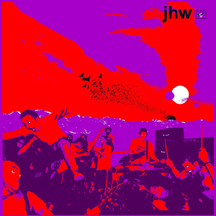
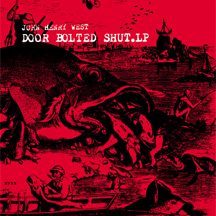
|
|
 |
 |
|
. |
|
 |
 |
Things you might want to know about Ebullition |
|
How many people work at Ebullition?
Two. Just Lisa and Kent.
Kent, of course, founded Ebullition, and Lisa has worked here for more than 13 years.
Who does what?
Lisa keeps track of all of the inventory in our office. She pulls all of orders, and she personally packs and ships 99% of all of the orders within the USA. She also helps with deciding on restock orders when we are low on inventory.
Kent does all of the accounting, and decides what we will carry. He does all of the catalogs and updates the web site on either Saturday or Sunday each week. He also ships all of the international orders. And he pays labels/bands and manages the restock orders with Lisa's help.
Can either of you read minds?
Surprisingly, no.
Thus if you send us an order or e-mail then please tell us who you are and what you are talking about. Believe it or not, there are a lot of people in the world that have the same first name. It is best to include your full name and address with every order, and if you are responding to an e-mail from us then please either quote our original e-mail or describe what we were talking about!
How do I get something distributed by Ebullition?
E-mail a description for the release, as well as a wholesale price to wholesale@ebullition.com and sooner or later Kent will get back to you. If he needs more information then he will ask. Don't bother sending sound files as Kent doesn't understand how to listen to them, and he certainly doesn't want to read your one sheet. Keep it simple.
What are your payment terms?
In general we work on consignment with a payment schedule that will be determined by the speed at which your releases sell. If your stock sells very slowly then you will get paid very slowly, and if your stock sells very fast then you will get paid very fast. Everything is subject to how busy we are. Being that we are only 2 people that can change quite quickly.
How come you haven't answered my e-mail?
As noted, Ebullition is only run by two people. Lisa does NOT work on the weekend, and she generally is off 2 Fridays a month. So if you e-mail her when she is off then you have to wait for her to get back. She is very good about e-mail and if you don't get a response within 7 days then something is wrong.
Kent does work on the weekend, but he doesn't answer e-mail every day. He tries to do the important e-mail on a very regular basis, but he gets a LOT of e-mail and sometimes he gets behind. It may take a few weeks to get a response, and if it isn't critical then it might take a lot longer then you would like.
Are you and Lisa married or dating?
No.
Lisa is married to Brett (This Machine Kills/Not For The Lack of Trying guitarist). They have two children, Xander and Quinn.
Is Ebullition a cult?
No.
It is true that Kent, Brett, Lisa, Quinn, and Xander all live together in one house.
That doesn't make us a cult, though I am sure that all of our various parents might think otherwise.
|
|
 |
 |
|
. |
|
 |
 |
Mailorder and Domestic Distro changes |
|
We have changed the rules for mailorder and for domestic distro. Huge changes.
Ebullition is a small company; just Lisa and I. Mailorder has become increasingly time intensive and expensive over the last few years. It isn't cost effective nor is it a good use of our time. Lisa would like more time with her son and family, and I would like more time in my life to pursue other interests. Over the years we have tried to integrate a 3rd person into the Ebullition team, but for various reasons it has never worked out long term. So we decided to make changes that would allow the two of us to run Ebullition without having to spend our entire lives here in this office.
The following changes are massive, and for most mailorder customers it will mean that we are effectively no longer doing mailorder. Domestic Distro customers won't really find many changes.
Here are the major changes.
We now have a $150 minimum order.
We now only have one catalog.
Everyone pays wholesale prices + postage.
We realize that a $150 minimum will be prohibitive for most people. However, for those that can consolidate their orders the final costs will actually be less. So for those of you that can do a $510 order you will find that you will be getting more records and CDs for less money.
For those that can't afford to do a $150 order then I suggest that you mailorder from any of the dozens and dozens of places that offer mailorder.
Our mailorder service has been shrinking each year. Last year we only did about 4 or 5 mailorders a day. That isn't much. Mailorder is less than 2% of our sales. Our main emphasis is on distributing to stores, other distros, people that sell at shows, and other mailorders.
I started doing mailorder in 1984. I personally did the mailorder until 1994 when Lisa took over doing the mailorder. Leslie, Chris, Brandy, Fil, and Dave all took their turns doing mailorder over the years. We have many customers that have been ordering from us for over 12 years. It has been a pleasure to serve you over these long years.
Hopefully, some of you will still order a few times a year. Perhaps try consolidating your orders with local friends.
In any event, Ebullition will still be doing our distribution. We hope that this change will allow us to enjoy more life and to serve our core customers more efficiently.
Sincerely, Kent McClard
|
|
 |
 |
|
. |
|
 |
 |
The Ebullition Owl |
|

In November of 2004 I built an owl box in one of the trees that lives in my backyard. An owl family now lives there. I took this photo of one of the owls.
The owl came out during the day because a cat was trying to attack them. The owl came out to protect the family. I chased the cat away. Cats are constantly coming to hunt the owls and wild birds that live in our yard.
Cats should never be allowed to run wild. They kill and taunt wild birds and small animals. If you own a cat please do not let it go outside. Letting your cat go loose is the equivalent of going around with a rifle shooting birds and small animals. If you care about the environment and wild animals then please do not let your cat go outdoors.
Cats are not natural. They are man-made hunters that do not belong in the wild. Wild animals do not know how to deal with them and unless you live in a very rugged place there are no predators to keep the cats under control. In many places in the world cats are decimating the natural habitat. In the USA cats are responsible for a massive decrease in songbird populations. In some states songbirds may go extinct due to the wholesale slaughter being caused by domestic and feral cats.
|
|
 |
 |
|
. |
|
 |
 |
Ebullition Releases going out of print!! |
|
When I started Ebullition my original goal was to keep everything in press. That has proved to be too hard, and ultimately a bit silly. I have decided to let a lot of my releases go out of print.
The following list of records will be going out of print. Once they are gone, they will never be repressed. Most items will not sell out anytime soon, but there are a couple of items that won't be around much longer (as well as a few items that are now out of print). Thanks. - Kent
(SOLD OUT) 3/12/93 - Comp 7" w/John Henry West, etc...
(153 left) ADMIRAL - Revolving and Loading 7"
(500 left) AMBER INN - All Roads Lead Home LP
(87 left) AMBER INN - Serenity In Hand 7"
(SOLD OUT) BREAD AND CIRCUITS - LP
(100 left) BLEED - True Colors Running 7"
(125 left) BORN & RAZED - Holy Wars 12"
(128 left) DOWNCAST - 7"
(40 left) DOWNCAST - LP
(SOLD OUT) ECONOCHRIST - Another Victim 7"
(84 left) ECONOCHRIST - Skewed 7"
(SOLD OUT) ECONOCHRIST - Trained To Serve LP
(200 left) END OF THE LINE - 12"
(125 left) EX-IGNOTA - Lazarus Is Back... 7"
(SOLD OUT) FAILURE FACE - All Pain, No Gain 7"
(7 left) FLOODGATE - Troubles A' Brewin 12"
(SOLD OUT) ICONOCLAST - Groundlessness of Belief 7"
(198 left) ICONOCLAST - the first 7"
(SOLD OUT) INCURABLE COMPLAINT - Blue Horses 7"
(200 left) IVICH - La Vie Devant Soi 10"
(200 left) JARA - three song 7"
(SOLD OUT) JULIA - LP
(SOLD OUT) LIFE, BUT HOW TO LIVE IT? - 12"
(125 left) MANRAE - Pacata Hibernia 7"
(125 left) MANUMISSION - Binary Lung 7"
(200 left) MANUMISSION - Diego Rivera 7"
(SOLD OUT) PORTRAITS OF PAST/BLEED - split 7"
(SOLD OUT) PORTRAITS OF PAST - 01010101 LP
(SOLD OUT) REVERSAL OF MAN - This Is Medicine LP
(102 left) SAWHORSE - 7"
(200 left) SAWPIT - 7"
(240 left) SEEIN' RED - Marinus 7"
(SOLD OUT) SEVERED HEAD OF STATE - 1st 7"
(SOLD OUT) SEVERED HEAD OF STATE - No Love Lost 7"
(SOLD OUT) SEVERED HEAD OF STATE - No Love Lost CDep
(SOLD OUT) SPITBOY - Rasana 7"
(SOLD OUT) SPITBOY - True self revealed 12"
(500 left) SUBMISSION HOLD - Waiting For Another Monkey... LP
(SOLD OUT) STILL LIFE - From Angry Heads... CD
(SOLD OUT) TORCHES TO ROME - 12"
(SOLD OUT) YAPHET KOTTO - The Killer Was... LP (green vinyl)
(SOLD OUT) YAPHET KOTTO - Syncopated... LP
(400 left) AMNESIA - comp LP w/Ordination Of Aaron, Scout, Three Studies For A Crucifixion, Car Vs. Driver, In/Humanity, Failure Face, Wellington, Lybernum, Ipecac, Silence Equals, Stephen Hero, and Thumbnail
(800 left) GIVE ME BACK - Comp LP with Econochrist, Seein' Red, Born Against, Spitboy, Profax, Downcast, Man Lifting Banner, Amenity, Suckerpunch, Desiderata, Bikini Kill, End Of The Line, Struggle, and Sawhorse
(325 left) HEARTATTACK #10 - comp LP w/Amber Inn, Shotmaker, Jihad, Uranus, Loomis Slovak, Ex-Ignota, Skyskraper, The Fisticuffs Bluff, K.A.S.H., Manrae, and incurable Complaint
(200 left) ILLITERATE - comp LP w/Finger Print, Kina, Gnezl Drei, Wounded Knee, Condense, Nothing Remains, Ivich, Voorhees, Ego Trip, Abolition, Blindfold, Married To A Murderer, and Hypocritical Society
(300 left) XXX - double LP comp w/Groundwork, Frail, Policy Of 3, None Left Standing, Via, Monster X, Pogrom, Threadbare, Endeavor, Portraits Of Past, Shatter The Myth, Prozac Memory, Trees Without Leaves, and Well Away
|
|
 |
 |
|
. |
|
 |
 |
Box Packing Hints |
Introduction
One of the worst things about working everyday at Ebullition is that I am forced to constantly tell people that the records or CDs they have sent me were destroyed. Literally, thousands of records come to us destroyed. At least once or twice every week I have to inform someone that the box they sent us arrived damaged.
Most of the time people blame the post office or the shipping company involved.
In my opinion 99% of the boxes that come to us are improperly packaged.
It is true that all of the shipping companies treat parcels badly. However, blaming them is not a solution. Blame doesn't repair broken CD cases or mend crushed LP jackets.
The only logical solution is to pack boxes with the knowledge that they will be dropped, thrown, tossed, kicked, rolled and generally treated poorly.
I once witnessed a woman at the post office try to ship a glass mug in a padded envelope. The clerk told her it would be destroyed. She sent it anyway.
In many ways that is how the punk community behaves with regards to this issue. There are also some pressing plants that can't seem to see their role in the carnage.
I had to struggle with this issue. I had to learn. I have been shipping stuff for 20 years and I have made many mistakes. At this point most of what we ship arrives in decent shape, but that takes patience and thought. No matter what sometimes boxes get wrecked. Damage can't be avoided 100% of the time but it can be avoid 99% of the time. There is no reason why thousands of records should arrive damaged at Ebullition each year.
This is my attempt to put a stop to that problem.
By putting this together I am trying to help people save money. This advice isn't meant to help me. It is meant to help you. If you are in a band or are starting a record label then do yourself a favor and learn how to properly send records and CDs. It will save you money and headache.
Hint #1: packing tape
Packing tape is very, very cheap. People that come in my office often laugh at me for using what they consider to be too much tape.
They are wrong.
A roll of packing tape costs less than $2. It would be better to use an entire roll of packing tape on a box then to have the contents of that box lost or destroyed. In my opinion there is no such thing as too much tape.
Try an experiment. Get two pieces of notebook paper. Tear one in half. Now take the other piece of notebook paper and secure a piece of packing tape to one side of the paper in both directions. Now try tearing that piece of notebook paper in half. You will see the difference.
Packing tape keeps the box secure and it helps the box to retain it's form as a box. It also keeps rain and other liquids from getting inside the box.
Here is a photo of a box that I recently received. You can see that the edges of the box came apart where no packing tape was present. The sender did put a small amount of packing tape on the box, and that kept it from coming completely apart.
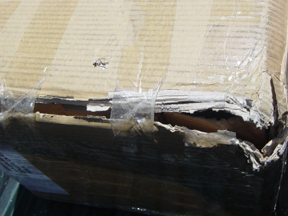
Here is another example of what happens to a box edge with no packing tape. As you can see the top edge that was taped stayed together, but the side with no tape was ripped open.
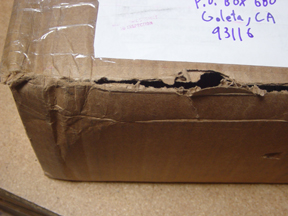
There are two tricks to properly taping a box.
First of all, tape every single edge. Every single edge should be taped. Every single edge. That means that every edge is completely covered in tape.
Repeat after me, "Every single edge!"
Secondly, you should go completely around the box with tape in BOTH directions. Tape is strong but it is twice as strong when layered in two directions. So tape every edge then go around each side so that the tape forms a crossing pattern.
Here is an example of a properly taped box.
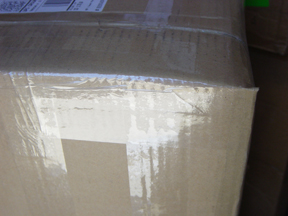
Lots of tape on all edges = good job!!
Here is another angle on the same box.
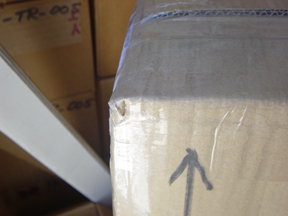
Packing tape is your friend. You can't have too many friends, and you certainly can't use too much tape!
I have received completely empty boxes before. The sender taped down the top of the box. The box came open at the bottom, go figure, and 200 7" records were lost.
A roll of packing tape is very cheap.
Hint #2: Double Box
Every box should be double boxed. That means having 2 boxes. One that your records or CDs go into and then take that box and put it inside another box.
This way if the outside box splits open, or gets a hole in it, or gets wet then the inner box will still protect the contents.
I don't have any photos for this. It is pretty simple: double box.
If a record label doesn't do this then I will stop ordering from that label because everything they ship me will look like crap.
Double box.
Hint #3: Packing Material
Packing material is used to protect the contents of the box. It seems obvious, but in reality many people don't understand the purpose of packing material.
I get hundreds of boxes every year where the sender used the records to protect the packing material. I am not joking.
Here is a photo to prove it. Can you say, "Duh."
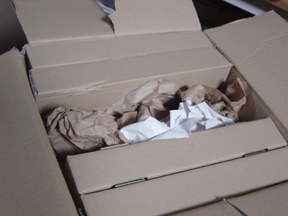
If this box gets damaged then the records will be destroyed but the packing material will be in great shape.
That must be some valuable packing material!
That isn't funny. Stupid. Careless. But not funny. Thousands of dollars are lost each year by people that make this mistake.
The contents that you are shipping go in the center of the box, and the packing material should go towards the outside.
Packing material is essentially a shock absorber. It is designed to take the hit when the parcel is dropped, kicked, smashed, thrown, sat on, stepped on, or what have you.
Most of the damage will come from the bottom and top. So in general it is a good idea to put packing material at both the top and bottom of the box. Keep it tight. You don't want things flying around inside your box.
Hint #4: Corners
The corners are the most likely part of a box to be crushed. The boxes will be dropped on the corners. I would say that 99% of all damage takes place in the corners. Try to keep the valuable things out of the corners.
Here is the corner of a box I received today.
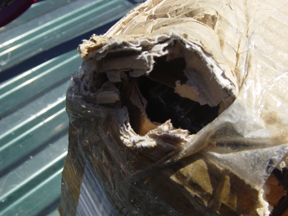
Keep valuables out of those corners!
Corners need the most protection, so put the packing material there, or cut corners off of other boxes and put them into the box to give extra support.
Here is a photo of a box with extra corners.
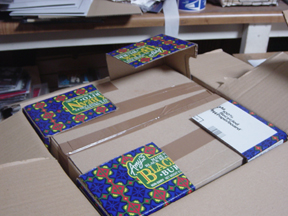
I have one of these vegan frozen burritos for lunch each day. Yummy. I buy them by the case to save money, and then I cut up the boxes to make corner protectors.
Hint #5: Priority
Not all boxes have mixed contents, but when they do there is a priority to
consider. Put the items that are the hardest to damage or the easiest to replace/fix in the most dangerous part of the box.
For example CD cases can be replaced, 7" covers are cheaper to replace and can sometimes be smoothed out. But LP jackets are very hard to replace.
Put the CDs and 7"s at the top and bottom, and put the LPs in the center. The CDs and 7"S can go at both the bottom and top while avoiding the corners, while LPs tend to span the whole width of the box.
Protect the LPs!!! Protect the LPs!!!
Hint #6: LPs should lay flat
Another test experiment for you. Take an LP that you don't care about. Hold it vertically in your hand and drop it from eye level. Most likely it fell on the edge or corner and was damaged.
Now take the same LP, hold it horizontally, and then drop it from eye level. Most likely it won't be damaged because it fell down flat.
Boxes of LPs tend to fall on their bottom edges. If the records are all standing vertically then every single record edge will slam the ground every time it is dropped.
It is far better to send LPs laying flat. If the box is damaged then only a few of the records will be crushed. If the records are all standing vertically then every single record will be damaged instead.
Sometimes the sides of boxes are what gets damaged, but for the most part it is the bottom and top. I find that packing the records laying flat really helps out in minimizing damage.
Outroduction
I hope this helps. No matter what you do damage will still happen, but if you prepare your boxes for the worst then 9 out of 10 times your box will survive the worst.
Good luck and I hope I never have to write you to tell you that your box was destroyed.
Kent/Ebullition
|
|
 |
 |
|
|
|
 |
 |
|
 |
 |
|


|

